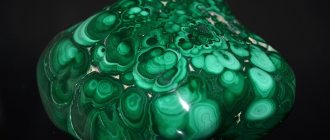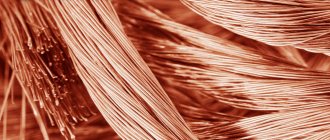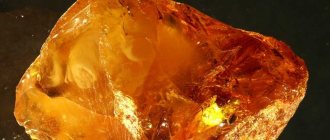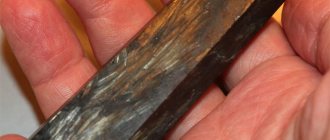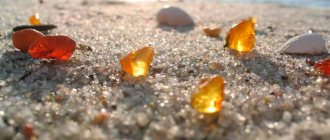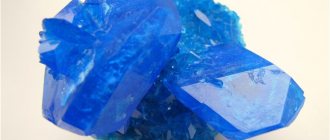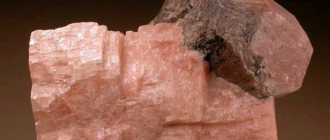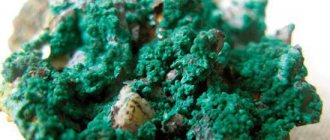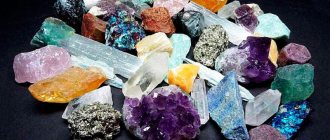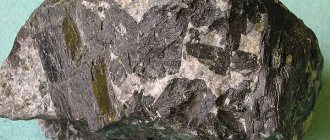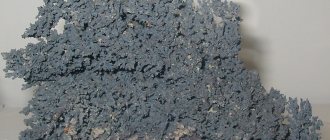Ophiocalcite stone is a beautiful ornamental material, very popular in ancient times.
- In Ancient Rome, mosaic floor paintings were made from it;
- In Ancient Greece - vessels for drinks, vases, tabletops and beds.
Today it is used to make crafts - boxes, rosaries, carved figures and figurines, bracelets, key rings. Although you can also find it in the interior.
The stone is distinguished by its high density and hardness; in these properties it is superior to marble, of which it is a close relative. The properties of ophiocalcite are also due to the fact that it contains veins of serpentine, also known as serpentine.
The magical properties of ophiocalcite
This stone combines the properties of the two main minerals of which it is composed - calcite and serpentine.
- Those who use rosaries or jewelry made from this stone need not fear the intervention of dark forces and evil spirits. The stone serves as a protective amulet that can repel the evil eye and damage.
- It also clears space of negativity, working on the principle of a filter. Therefore, the stone itself requires regular cleaning with running water.
- The mineral helps you tune in to the wavelength of other people, and begin to feel their worries and experiences more subtly. From this point of view, an ophiocalcite talisman is indispensable for doctors, psychologists, healers, massage therapists and simply those who work with other people.
- The stone helps to bring good luck into life and improve relationships with a loved one. If you are in search of a soul mate, then ophiocalcite will help you make the right choice and will ward off people who want to be close to you for selfish or other reasons that have nothing to do with sincere feelings.
- Ophiocalcite took powerful healing properties from the serpentine. It helps relieve irritation and fatigue, relieve muscle tension, normalize blood pressure and heart rate. It is useful to have ophiocalcite balls or rosaries at home that you can finger in your hands.
Ophiocalcite - a stone from the ancient world
Ophiocalcite - a stone from the ancient world
View all products from Ophiocalcite
Let's move back twenty-five centuries and imagine the front room of a spacious villa on the outskirts of Rome. The first rays of the rising sun penetrate through the high arched windows, illuminating the plastered walls covered with colorful frescoes, silk bedspreads on exquisite boxes and bronze statues of gods. The sun's glare plays on the patterned tiles of the mosaic floor, whose whimsical design is as fresh as the cool morning of the ancient and young world. The shades form a single pattern, and it is impossible to believe that this is actually a mosaic made of pieces of colored marble. The graceful feet of a young maid, carrying a jug of spring water for her morning ablution to her noble mistress, count down the shiny slabs, but suddenly the girl, listening to the singing of the morning birds, slips, and the heavy bronze jug falls with a ringing sound on the stone. The maid falls to her knees in horror and carefully examines the slabs - are there any potholes or chips? She will be punished if she dared to spoil the mosaic, for which the owners specially ordered expensive and rare green marble, which is rarely found even in the houses of the most eminent dignitaries... From the dossier:
Green marble, or ophiocalcite, is limestone with serpentinite veins.
Mineralogical class: rock, fine-grained serpentine marble. Crystals are opaque. The shine is silky, glassy. Hardness 5.0-6.0 on the Mohs scale, density 2.6 g/cm3. The maid of Ancient Rome could be calm - ophiocalcite, a translucent green mineral, which in ancient times was considered a green variety of marble, is much superior to the latter in hardness, and even a fall from a height of a metal vessel would not have harmed it. This interesting ornamental gem consists of a marble base and inclusions of noble opite - an iridescent, opal-like, precious variety of the well-known serpentine stone in Russia. If a natural coil resembles a snake skin, then on the pale green or yellow-green surface of ophiocalcite a mesh or striped pattern blooms from olive, marsh or brownish veins diverging in different directions, reminiscent of small snakes crawling in the spring grass - it’s not for nothing that the word “ophite” is used. means "snake" in Greek. Ophiocalcite was extremely popular in ancient times - from Ancient Rome and Ancient Greece, where, in fact, it was first discovered, the stone migrated to the center of the Christian world, Byzantium, where it adorned palaces and temples for a long time. Ophiocalcite came to the Islamic world with bloody wars against infidels, as a result of which, along with gold and jewelry, a beautiful green stone fell to the winners, which came to the court of eminent Muslims who adore the green color in the interior - now harem beauties frolicked among the green patterns and ate the twitter of the powerful Sultans. Ophiocalcite was also loved in Ancient China, also known for its passion for the eye-soothing effect of the color of leaves and herbs. Green marble did not lose its popularity during the Renaissance, when, in the wake of a surge of interest in everything antique, Italian masters began to revive ancient mosaic techniques and old facing materials - marble white-green flowers now bloomed in the brilliant residences of European kings. In Tsarist Russia, before the discovery of ophiocalcite deposits in the Urals in the 18th century, stone was imported from Greece, whose mines, which began working before our era, had not yet become scarce by that time - the stone was widely used for cladding and interior decoration of buildings, making vases, tabletops and decor items. Today, ophiocalcite is still popular - due to its degree of abrasion, resistance to temperature changes and wear resistance, it is ideal for finishing stairs and floors, even with high traffic intensity. Due to its low water permeability, it is often used for finishing wet rooms - swimming pools, bathrooms, saunas and baths. Of course, modern craftsmen also use stone to create jewelry and small sculptures - you can find beads, rosaries, bracelets, keychains, vases, boxes, figurines and other decorative items made from ophiocalcite. It is often found in exclusive stone paintings and panels made using the Florentine or bulk mosaic technique. Ophiocalcite is still being mined in the Urals; in addition, it is mined in Central Asia, Transcaucasia and Ukraine. Like serpentine, ophiocalcite has excellent healing properties, but the range of its effects is wider, since it contains two interrelated principles: marble (Yin) and ophite (Yang). Therefore, lithotherapists use ophiocalcite balls for manual restorative massage, restoring energy balance and harmonizing the functioning of the entire body. In addition, ophiocalcite improves blood circulation, promotes the resorption of hematomas, relieves fatigue and stress, and helps with neurasthenia, muscle spasms and hand tremors. The stone can warn its owner about an impending disease: it becomes warmer when health improves, and seems to get colder if an exacerbation of the disease is approaching. Like all other varieties of serpentine, it is believed that ophiocalcite serves as a powerful amulet against all kinds of poisons, poisonings and gastrointestinal problems. The stone is energetically connected with the Anahata heart chakra, which suggests that it is useful for heart diseases and for normalizing the functioning of the cardiovascular system. Ophiocalcite is a powerful space purifier, so it is good to have an object or part made of ophiocalcite at home, which will act as a filter, passing through which any negative impact will be neutralized. It strengthens character, develops will and self-control, smoothes out experiences and emotional outbursts. This is a talisman for pharmacists, doctors, healers, homeopaths and massage therapists - it nourishes them energetically, gives them strength and the ability to actively help people, feeling the essence of their physical problems. Ophiocalcite is a stone for an inquisitive researcher who dreams of knowing himself, discovering the secrets of the surrounding world and the universe, who never tires of learning new things - the gem will help such a person to successfully gnaw on the granite of science and lift the curtain on the most exciting mysteries of the universe. Ophiocalcite also protects from magical interference in our lives - damage, evil eye, love spell. In personal life, ophiocalcite helps maintain self-confidence and attractiveness for a partner, attracts mutual love and protects against the wrong choice. Astrologically, ophiocalcite is indicated for Aries, Gemini, Cancer and Pisces, as well as people with blood group II. If you decide to purchase a product made of ophiocalcite, then this mineral, which has seen the rise and fall of so many great empires, will illuminate you with its soft greenish shine, reminiscent of the play of light in the crowns of old oak trees, and will bring the most important thing to your home - health and tranquility. And everything else, as popular wisdom says, will follow by itself.
View all products from Ophiocalcite>>>
Ophiocalcite and the signs of the Zodiac
- The magical properties of the ophiocalcite stone will be especially useful for Pisces, Cancer, Gemini and Aries.
It will help Pisces develop will and self-control, strengthen character, and smooth out emotional outbursts.
Cancers will find in him an indispensable assistant in career matters and relationships with people; he will help them to know themselves and discover new talents and inclinations.
Ophiocalcite fuels Aries with energy, which helps to stay afloat even during periods of depression. With the help of this stone, they quickly recover from blows of fate and regain lost balance.
Geminis will find harmony, health and tranquility if they always have a rosary or other thing made of ophiocalcite with them.
Description of calcite stone
The mineral is calcium carbonate. There are many varieties of it. This is a versatile and multifunctional stone. Its various names are known. The name calcite is translated from Greek as “lime,” which is completely true. Until the mid-19th century, the gem was called “lime spar.”
Its chemical composition contains not only calcium carbonate. It also contains impurities of iron, magnesium, zinc and manganese. They influence the appearance, shape and physical and chemical characteristics of the mineral.
How to distinguish real calcite from a fake
Natural calcite is often replaced with artificial one. To distinguish the original from a fake, you should pay attention to the following methods:
- Using vinegar. When interacting with the substance, calcite may dissolve.
- By breaking off a piece from the rock. In a natural, unprocessed sample, it will have the shape of a parallelepiped.
- By carefully examining the crystals. In natural calcite, microcracks and uneven color will be noticeable. A uniform pattern and perfect transparency indicate that the mineral is fake.
Natural calcite is characterized by double refraction of the rays that pass through it. Natural stone resembles the action of a magnifying glass.
To enhance the effect of calcite, it must be combined with silver.
Areas of application of calcite stone
In fact, it is easier to designate areas where a given mineral is not used than the other way around. Calcite is a very useful mineral that has no analogues. Humanity will not be able to function at the same level as it does now without it.
Calcite is actively used in the metallurgical, paint and varnish and food industries. The construction, agricultural, astronomical and jewelry industries cannot do without it. He is involved in many areas of production.
Many people are interested in how the mineral is used in astronomy and the food industry. It is known that a type of calcite is limestone, which is used in the manufacture of cement. The decoration of rich and expensive premises is not complete without marble. It is noteworthy that the stone is used in the production of baking soda and sugar.
Iceland spar has amazing optical properties. It is used in the manufacture of optical instruments such as telescopes and lasers. Without this material, it is impossible to create radio electronics, computing devices and quantum generators. It is obvious that the areas of application of calcite are incredibly wide. This is a very valuable and sought-after material.
Varieties and colors of the mineral
Calcite comes in many varieties. It is quite difficult to list all forms of calcite, because scientists count only 800 of its modifications. But among the main varieties we can distinguish:
- Anthraconite is a black gem mixed with bitumen.
- Argentina - silvery plastic crystals.
- Iceland spar is calcite, which has an optical effect of maximum birefringence.
- Simbircite is a translucent gem in red and yellowish tones.
- Travertine is the most common form found as sedimentary rocks.
- Ophiocalcite is a stone that contains veins of another mineral. Because of this, a pattern appears on the stone. The mineral belongs to the ornamental varieties of marble.
The gem is characterized by a wide range of color palettes. The most common colors found in nature are white and yellow calcite. But, in addition to these shades, there are also:
- honey;
- pink:
- green;
- brown;
- grey;
- orange;
- blue or bluish.
Watch videos of what the stone looks like:
Calcite and Zodiac
Calcite is not associated with any planet, so it suits everyone according to their zodiac sign. But his favorites are fiery Leos, Sagittarius and Aries.
Only Scorpios are required to be careful. If a person is constantly on a negative wave, plotting intrigues against his neighbors, the stone will only cause problems.
| Zodiac sign | Compatibility |
| Aries | + |
| Taurus | + |
| Twins | + |
| Cancer | + |
| a lion | + |
| Virgo | + |
| Scales | + |
| Scorpion | — |
| Sagittarius | + |
| Capricorn | + |
| Aquarius | + |
| Fish | + |
(“+++” – fits perfectly, “+” – can be worn, “-” – is strictly contraindicated).
Healing properties of calcite stone
Calcite successfully copes with diseases of the gastrointestinal tract. It is believed that the healing qualities depend on its shade. Consequently, the impurities in its composition play an important role.
Yellow calcites treat kidney diseases, and red ones treat intestinal problems. Orange stones improve digestion and the condition of the spleen. Blue stones are good for the respiratory organs. Green minerals heal arthritis, arthrosis, and torn muscles. Thanks to them, broken bones heal quickly.
If a person suffers from migraine or toothache, he should wear a pendant with matte or transparent calcite. It increases endurance and protects against back diseases. For cataracts, it is necessary to apply the mineral to the eyes for a short period of time.
Calcite beads in a silver frame protect against colds and strengthen the heart muscle. True, the mineral has contraindications. It causes tissue growth. At the same time, the growth is happening rapidly. This means that if a person has a tumor or sprain, he should not use this stone. This is very dangerous and fraught with consequences.
How to care for stone
Due to the fragility of the gem, jewelry needs proper care and storage. To prevent the stone from deteriorating over time and losing its original appearance, follow the following rules when caring for it:
- Remember that the stone is susceptible to many external factors. Do not allow household chemicals or acids to come into contact with it. Do not expose to hot sun rays.
- Store in a case lined with soft fabric or a special bag. Keep away from other stones.
- Clean dirt with a soft cloth or brush in soapy water.
To charge the energy power of the stone, hold it under running water, dry it and leave it to warm in soft sunlight.
Varieties of calcite
Calcite is the world leader among minerals in terms of the number of types and varieties. They are mentioned when describing the mineral. Scientists have identified almost eight hundred of them.
There are several main modifications of the breed:
- anthraconite - black color created by bitumen impurities;
- argentine - plate minerals of silvery tones;
- Iceland spar – endowed with the maximum birefringence for calcites;
- simbircite – translucent, red or yellow shades; named after the location of the largest deposits (Simbirsk province of Russia, now Ulyanovsk region of the Russian Federation);
- travertines - limestone, chalk, fossilized remains of marine flora; the most numerous variety.
The stone looks different. Scale, marble, marble onyx, pearls are also calcites.
Calcite is often confused with dolomite and magnesite, but these are different minerals:
- dolomite is a double carbon dioxide salt of calcium and magnesium; resembles limestone, but much stronger;
- magnesite - anhydrous magnesium carbonate from the calcite group with a similar crystal structure; but it dissolves in acids only when heated.
Calcite has a wide range of colors, the most common colors being white and yellow. There are blue, pink, reddish, brown, gray, and crimson stones.
Orange calcite
Physical properties of the mineral
Calcite belongs to the class of carbonates. It is calcium carbonate with the chemical formula CaCO3. The mineral is found in pure form or with impurities in its composition. Calcite crystals without impurities are large, transparent, with a glassy sheen, and regular shapes (octahedrons, prisms, rhombuses). Shades with a pearlescent sheen and less transparency give rise to impurities of manganese (red-pink), iron (yellow), and other elements.
Basic physical properties of calcite:
- density – 2.71 g/cm3;
- cleavage – ideal;
- fracture – stepwise;
- hardness on the Mohs scale – 3; it is one of the softest minerals; easily scratched by glass or a needle;
- when heated to 470 °C it turns into aragonite.
| Formula | CaCO3 |
| Color | Colorless, white with various shades: pink (Mn), yellowish (Fe), bluish, greenish, apple green (Ni). Allochromatic color: black (organic), red (hematite), yellow (hydrogoethite) |
| Stroke color | White |
| Shine | Glass |
| Transparency | Transparent |
| Hardness | 3 |
| Cleavage | Very perfect |
| Kink | Conchoidal |
| Density | 2.71 g/cm³ |
| singonia | Trigonal |
| Refractive index | nω = 1.640—1.660 nε = 1.486 |
| Thermal properties | When heated to 470 °C or under increased pressure, it turns into aragonite. With further heating, calcite decomposes to form carbon dioxide and lime. |
The uniqueness of calcite is its strong birefringence. By this characteristic, it can be easily distinguished from quartz or other outwardly similar mineral.
Diagnostic signs
It is easy to identify calcite: its distinctive properties are perfect rhombohedral cleavage and low hardness. A characteristic reaction with hydrochloric acid is that it interacts with the rapid release of carbon dioxide according to the reaction:
Colors and types of calcite stone
A pure mineral without inclusions or impurities is transparent. It is called "Iceland spar". If you look through it at an object, it will become twice as large. It turns out that it has powerful birefringence. It is noteworthy that sometimes the transverse size of the stone reaches 7 meters, and the weight can be more than 20 tons.
The color of calcite is determined by the impurity content. For example, manganocalcite has a pink tint. It contains a small amount of a substance such as manganese. If the mineral contains cinnabar or hematite, it turns a rich red color.
A minor admixture of malachite gives the mineral its green color. Pyrite contributes to the blue color, azurite to the blue color, and iron to the yellow-brown color.
This is a fairly common gem. Numerous varieties of calcite are found in nature. They depend on the origin (sedimentary, igneous, metasomatic and hydrothermal) of the mineral. It turns out that its formation occurs in volcanoes, caves, lakes, oceans and seas.
For example, stone of sedimentary origin is concentrated in large basins. The remains of marine life, algae and other organic matter serve as building material for it. A type of mineral is pearl, the color range of which is very wide. It ranges from matte white to black shades.
Jewelry with mineral
Jewelry made from calcite is quite rare. But there are craftsmen who can beautifully polish and select a setting for a stone. Most often among the decorations you can find:
- earrings;
- rings;
- pendants, pendants.
It is much more difficult to find calcite bracelets.
The stone will fit well into any style, the main thing is to choose the right outfit. A light cocktail dress or blouse with classic pastel trousers or a skirt is suitable for this.
Thanks to the wide selection of calcite shades, you can choose a piece of jewelry for any occasion.
View this post on Instagram
Posted by Designed ©️ by Koko… (@bykoko_official) Apr 26, 2019 at 6:42 am PDT
View this post on Instagram
Publication from decoration, master classes (@rinabead) Jun 29, 2022 at 10:23 PDT
View this post on Instagram
Posted by tagotika (@tagotika) Jun 25, 2022 at 8:19 am PDT
Calcite deposits and processing
Calcite is mined all over the world. Calcite is mainly mined:
- in Iceland;
- basalts of Lower Tunguska, in Siberia;
- Central Asia;
- in the Urals in Russia.
The highest quality minerals come from deposits located:
- in England;
- the Iseberg sites near Harding Spring in New Mexico;
- Kongsberg, in Norway;
- Pribram, in Czechoslovakia;
- Alston Moor and Egremont, in Cumberland.
Gem varieties are determined by their location.
For example, transparent calcite crystals are mined:
- in Russia;
- some areas of Central Asia.
Chalk in the form of rocks is widespread:
- in Russia, in the Belgorod region;
- in Donbass, Ukraine.
Marble is mined:
- in the Urals;
- in Karelia;
- in Transbaikalia.
Onyxes with calcite in their composition can be found:
- in Transcaucasia;
- on the territory of Georgia and Armenia.
Stone processing involves cleaning it from dirt and polishing it. It is rarely cut into geometric shapes. More often, the natural mineral is simply polished until it shines.
